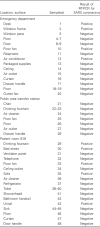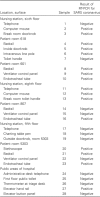Severe acute respiratory syndrome coronavirus on hospital surfaces
- PMID: 15356778
- PMCID: PMC7107915
- DOI: 10.1086/422652
Severe acute respiratory syndrome coronavirus on hospital surfaces
Abstract
Background: Health care workers continued to contract severe acute respiratory syndrome (SARS), even after barrier precautions were widely implemented.
Methods: We explored the possible contribution of contaminated hospital surfaces to SARS transmission by swabbing surfaces in 2 hospitals and testing the swab samples by reverse-transcriptase polymerase chain reaction (RT-PCR) and viral culture.
Results: Twenty-six of 94 swab samples tested positive for viral RNA. Swab samples of respiratory secretions from each of the 4 patients examined tested positive by RT-PCR, as were 12 of 43 swabs from patient rooms and 10 of 47 swabs from other parts of the hospital, including the computer mouses at 2 nursing stations and the handrail of the public elevator. Specimens from areas with patients with SARS in the most infectious phase of illness (days 5-15 after onset) were more likely to be RNA positive than were swab specimens from elsewhere (24 of 63 samples vs. 2 of 31 samples; P=.001). All cultures showed no growth.
Conclusions: Although the viruses identified may have been noninfectious, health care workers should be aware that SARS coronavirus can contaminate environmental surfaces in the hospital, and fomites should be considered to be a possible mode of transmission of SARS.
Figures



References
-
- World Health Organization. Consensus document on the epidemiology of severe acute respiratory syndrome (SARS) Geneva: World Health Organization; 2003.
-
- Olsen S, Chang H, Cheung T, et al. Transmission of the severe acute respiratory syndrome on aircraft. N Engl J Med. 2003;349:2416–2422. - PubMed
-
- Centers for Disease Control Prevention. Update: outbreak of severe acute respiratory syndrome—worldwide, 2003. MMWR Morb Mortal Wkly Rep. 2003;52:241–6. 248. - PubMed
-
- Centers for Disease Control Prevention. Cluster of severe acute respiratory syndrome cases among protected health care workers—Toronto, Canada, April 2003. MMWR Morb Mortal Wkly Rep. 2003;52:433–6. - PubMed
Publication types
MeSH terms
Substances
LinkOut - more resources
Full Text Sources
Miscellaneous

